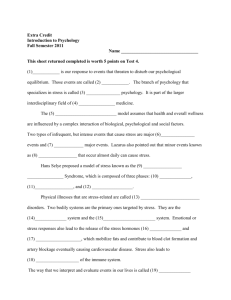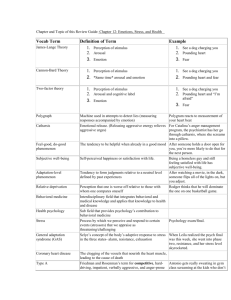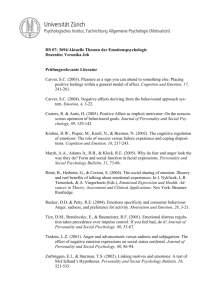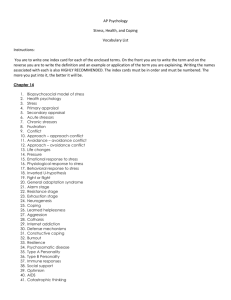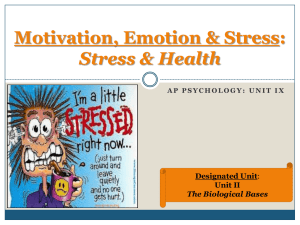Stress and Coping - An Economic Approach
advertisement
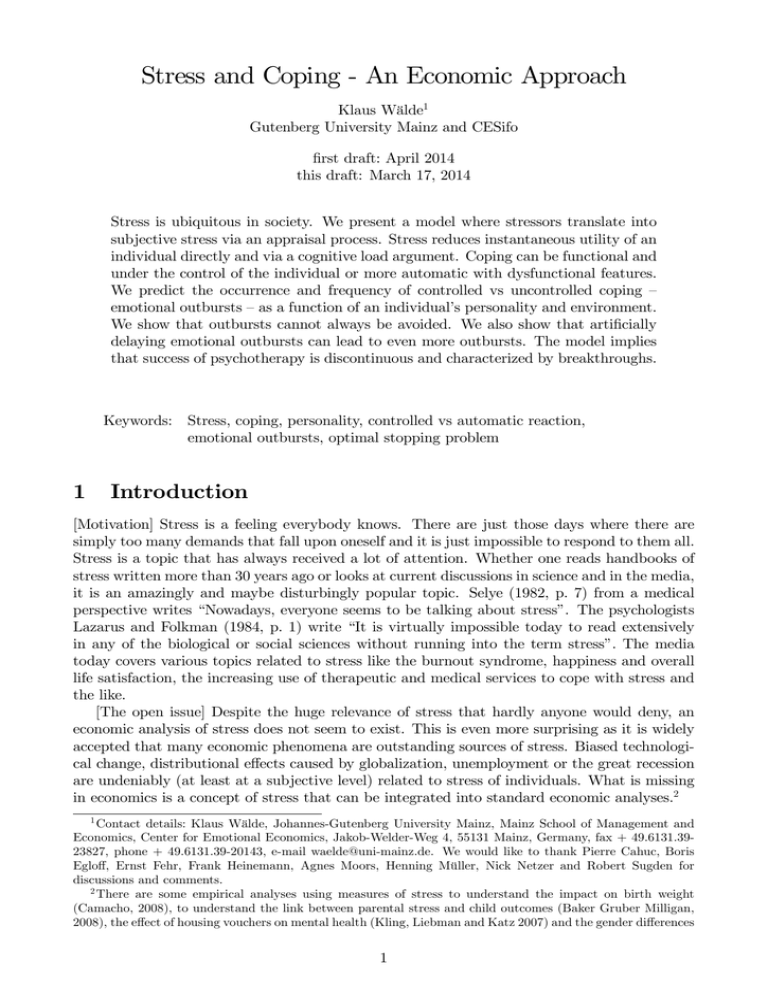
Stress and Coping - An Economic Approach Klaus Wälde1 Gutenberg University Mainz and CESifo …rst draft: April 2014 this draft: March 17, 2014 Stress is ubiquitous in society. We present a model where stressors translate into subjective stress via an appraisal process. Stress reduces instantaneous utility of an individual directly and via a cognitive load argument. Coping can be functional and under the control of the individual or more automatic with dysfunctional features. We predict the occurrence and frequency of controlled vs uncontrolled coping – emotional outbursts –as a function of an individual’s personality and environment. We show that outbursts cannot always be avoided. We also show that arti…cially delaying emotional outbursts can lead to even more outbursts. The model implies that success of psychotherapy is discontinuous and characterized by breakthroughs. Keywords: Stress, coping, personality, controlled vs automatic reaction, emotional outbursts, optimal stopping problem 1 Introduction [Motivation] Stress is a feeling everybody knows. There are just those days where there are simply too many demands that fall upon oneself and it is just impossible to respond to them all. Stress is a topic that has always received a lot of attention. Whether one reads handbooks of stress written more than 30 years ago or looks at current discussions in science and in the media, it is an amazingly and maybe disturbingly popular topic. Selye (1982, p. 7) from a medical perspective writes “Nowadays, everyone seems to be talking about stress”. The psychologists Lazarus and Folkman (1984, p. 1) write “It is virtually impossible today to read extensively in any of the biological or social sciences without running into the term stress”. The media today covers various topics related to stress like the burnout syndrome, happiness and overall life satisfaction, the increasing use of therapeutic and medical services to cope with stress and the like. [The open issue] Despite the huge relevance of stress that hardly anyone would deny, an economic analysis of stress does not seem to exist. This is even more surprising as it is widely accepted that many economic phenomena are outstanding sources of stress. Biased technological change, distributional e¤ects caused by globalization, unemployment or the great recession are undeniably (at least at a subjective level) related to stress of individuals. What is missing in economics is a concept of stress that can be integrated into standard economic analyses.2 1 Contact details: Klaus Wälde, Johannes-Gutenberg University Mainz, Mainz School of Management and Economics, Center for Emotional Economics, Jakob-Welder-Weg 4, 55131 Mainz, Germany, fax + 49.6131.3923827, phone + 49.6131.39-20143, e-mail waelde@uni-mainz.de. We would like to thank Pierre Cahuc, Boris Eglo¤, Ernst Fehr, Frank Heinemann, Agnes Moors, Henning Müller, Nick Netzer and Robert Sugden for discussions and comments. 2 There are some empirical analyses using measures of stress to understand the impact on birth weight (Camacho, 2008), to understand the link between parental stress and child outcomes (Baker Gruber Milligan, 2008), the e¤ect of housing vouchers on mental health (Kling, Liebman and Katz 2007) and the gender di¤erences 1 [The objectives] The …rst and foremost objective of this paper is therefore to provide a formal framework to think about stress and its implications. This approach follows “a desire to expose how <existing views> are wrong” (all quotes in this paragraph are from Rabin, 2013) or, to put it a bit more positive, to work out what existing views actually mean. Theories as developed in most social sciences are what could be called “imprecise theories”. Models of stress and coping as developed in other disciplines lack mathematical rigor and precision. This makes it “just harder to identify ‡aws”. Translating standard psychological views into an otherwise mainstream economic model allows us to “see their limits that can guide us in further improvements”. To make the point most clearly: What is a stressor, what is stress, what is coping once these concepts are cast into a formal framework?3 [The setup] The model of section 2 represents stress as a subjective feeling captured by a stochastic state variable which increases in the presence of stressful events, stressors, and falls by coping measures or pleasant events. The e¤ect of stressful or pleasant events and of coping measures on stress depends on the personality of the person under consideration. As will be discussed in the main text, the personality measures used here are “deeper” measures of personality than measures popular in the psychological or economic literature like e.g. the “Big 5” (see John, Naumann and Soto, 2008, for the background in psychology and Borghans et al., 2009 for a general discussion of applications in economics). The process starting with the stressor and ending with stress is an example of what psychologists call an appraisal process, i.e. the evaluation of events “with respect to their implications for well-being”(Lazarus, 1999, p. 75 )4 of the person. Here as well, we will discuss the relationship between our stressor-stress link and appraisal theories in psychology. Stressors are kept exogenous, stress results from simple parametric links such that we can put our focus on endogenous coping measures which are optimally chosen (under some constraints) by the individual. Starting with stressors and following a distinction made in psychology, we allow events to occur either relatively regularly or more rarely. Historically, the more rare events were seen as the classic sources of stress. A widely cited list of stressors was compiled by Holmes and Rahe (1967) in their Social Readjustment Rating Scale (SRRS). This scale includes events (in descending order of stressfullness) like ’death of spouse’, ’divorce’, ’jail term’, ’…red at work’ and so on, concluding with ’vacation, ’christmas’and ’minor violations of law’. It has later been discovered that even in the absence of any of the 43 events listed in the SRRS, individuals can be under high stress given “daily hassles” (Kanner et al., 1981) such as ’losing things’, ’don’t like fellow workers, ’too many obligations’and the like. Our speci…cation for the evolution of stress allows for both types of events re‡ecting the fact that empirically both of them matter.5 When modelling the e¤ect of a stressor on the stress level of an individual, we allow for intermediate cognitive processes of the individual experiencing a certain stimulus and displaying the response (Lazarus, 1993). These appraisal processes are captured in our setup by parameters which describe how a stressor translates into stress.6 The channel through which stress is detrimental to an individual’s utility is motivated by the literature on cognitive load7 . This literature builds on the view that cognitive processes in abilities to cope with stress (Kling, Ludwig and Katz 2005). The theoretical analysis of anxiety and anticipated emotions by Caplin and Leahy (2001) use stressful events as an example how anxiety can be built up (of which an example is a medical procedure, see Caplin and Leahy, 2004). The evolution of stress over time and the role of appraisal and coping is not studied by them, however. 3 The technical answer in chronological order: An exogenous parameter, a state variable and a control variable. 4 For a full-scale summary of appraisal theory, see Scherer et al. (2001), for a recent analysis of the role of appraisal in emotion, see Moors and Scherer (2012). 5 To be fair, there are many “little things in life” that can reduce stress. In fact, Kanner et al. (1981) also inquire about “uplifts” in their questionaire. 6 Appraisal is a highly complex process (see e.g. Scherer et al., 2001) which is hard to be captured by one parameter only. If a paper focused on appraisal only, more details can be taken into account. 7 This literature seems to consist of various relatively independent substrands. An introduction from the 2 can best be understood by using the concept of a working memory.8 This working memory has a certain capacity for processing information. Stress, anxiety or other strong feelings imply cognitive load which reduces the amount of resources available for other information processing. To make a simple example, stress reduces the ability to work intensively and focus on certain activities, say, at work. In fact, we will model the negative e¤ects of stress on individual wellbeing by modelling the performance-reducing e¤ect of stress. Stress reduces e¤ective labour supply at work. Turning to coping strategies, coping seems to be so heterogeneous that it appears hard to even agree on how to classify coping behaviour (Skinner et al., 2003). Standard classi…cations, however, distinguish between “emotion focused” copying strategy as opposed to “problem focused” behaviour which addresses the stressor itself (Lazarus and Folkman, 1984, ch. 6 ).9 Other classic categories include “functional” vs. “dysfunctional” approaches whereas modern views of coping often include a distinction between “automatic” processes and “controlled” processes (e.g. Conner-Smith et al. 2000, Skinner and Zimmer-Gembeck, 2007).10 Coping behaviour in our model can easily be understood using these categories. The feature of coping we emphasize in this paper is its stress-reducing nature. We therefore model an “emotion focused”coping strategy. Our expected utility maximizing individual reacts optimally to subjective stress levels by choosing a certain amount of costly stress-reduction activities. This reduces stress in a gradual and deterministic fashion. This is a “controlled” process. At the same time, however, we allow the individual to be overwhelmed by her stress experiences. Being overwhelmed triggers behaviour that can be understood as uncontrolled and that leads to a discrete and fast reduction of stress. This re‡ects the “automatic” process of the above categorization. As examples for the smooth coping style, think of ’sorting things out’, ’talking to a friend’or ’doing sports’. The more violent and less controlled behaviour stands for ’emotional outbursts’ taking the form of yelling, making gestures while driving the car, getting drunk, becoming aggressive and the like. Section 3 models individual behaviour as an optimal stopping problem.11 Stress evolves stochastically over time and is controlled by smooth coping. Stress can increase and decrease in discrete ways by negative or positive surprises.12 When the stress level is too high, an emotional outburst occurs. The outburst reduces the stress level by a discrete amount. Given optimal behaviour, the evolution of stress continues endlessly with occasional surprises and outburst and continuous optimally chosen smooth coping measures. [Findings] Section 4 …nds that coping behaviour crucially depends on the interplay between the situation (stressors) and the individual’s personality.13 While a strong negative surprise perspective of learning is provided by Paas et al. (2003). A recent contribution to the understanding of the e¤ect of cognitive load on performance is by Ho¤mann et al. (2013). The role of cognitive load in the processing e¢ ciency theory and the attentional control theory both attempting to understand the role of anxiety for performance is surveyed in Derakshan and Eysenck (2009). 8 The view goes back to Baddeley and Hitch (1974). See e.g. Smith and Kosslyn (2007, ch. 6) for an introduction. 9 Economics is full of problem-focused coping styles. An unemployed worker putting e¤ort into searching for a job would be one such example. 10 This follows the tradition of dual-process models used in psychology more widely. See Chaiken and Trope (1999) for an overview and Strack and Deutsch (2004) or Sherman et al. (2008) for more recent contributions. 11 Optimal stopping features arise as emotional outbursts imply …xed utility costs in our setup. In this sense, the paper is related to e.g. Bentolila and Bertola (1990), Bertola and Caballero (1994) and Dixit (1989). For an excellent introduction and an overview in depth of various model structures, see Stokey (2008). Optimal stopping problems in the presence of Poisson uncertainty is treated very brie‡y in Dixit and Pindyck (1994 ch 5.B) and was used by Ahlin and Shintani (2007) or Chen and Funke (2005). 12 Surprises occur when the expected outcome of some event di¤ers from the subjective expectation of an individual with respect to this outcome. This is related to the disappointment, regret and rejoicing literature of Loomes and Sugden (1982, 1986), Bell (1985) and others. 13 Do individuals exhibit heterogeneous behaviour because of heterogeneous circumstances (technically speak- 3 can induce any individual to display uncontrolled coping styles, our setup suggests to classify individuals into “stress-prone” and “stress-resistant” individuals. Stress-resistant individuals never display emotional outbursts in the absence of negative surprises. Stress-prone individuals can display emotional outbursts even when there are no negative surprises. Daily hassles alone can lead to overwhelming stress experiences. Yet, this is not necessarily the case. Even stressprone individuals can be “good stabilizers”, i.e. they can experience reducing stress levels over time. This is conditional on their initial stress-level. If the latter is too high, they turn into “bad stabilizers” and will forseeably display an emotional outburst at some deterministically given future point in time. Due to this dependence of behaviour on the current stress level, stress-prone individuals display more volatile behaviour than stress-resistant individuals.14 An outburst theorem will then relate situational and personality parameters to allow a prediction under which conditions and outburst will occur. The “growth rate of stress”, the individual’s tolerance level (above which outbursts occur) and the current stress level all play a role. We then ask what would happen if individuals could control their tolerance level. Surprisingly, we …nd that outbursts occurring early, i.e. at low stress-levels, have higher chances of permanently reducing the stress level of an individual than emotional outbursts that take place only late. Suppressing outbursts is therefore not a good idea. We thereby provide a rationale for common recommendations to “not bottle one’s anger up inside“ or to allow for “air-cleaning” angry outbursts (Bushman, Baumeister and Phillips, 2001). For a bad stabilizer, we then compute the frequency with which outbursts occur when the individual is caught in an “outburst cycle”. We …nd that a higher growth rate of stress and a higher tolerance level leads to a higher frequency of outbursts. This again points to the fact that high tolerance levels might not be a desirable feature. The intensity of an outburst, i.e. the amount by which stress is reduced as a consequence of the outburst, has ambiguous e¤ects on the frequency of outbursts. One could believe that a highly productive outburst technology is desirable, i.e. it would decrease the frequency of outbursts. At the same time, however, when outbursts reduce stress by a large amount, the individual will anticipate this and reduce costly smooth stress-reduction activities. This in turn increases the frequency of outbursts. We …nally ask how individuals react to positive and negative surprises. We do this by analytically computing the distributions of stress for stress-prone and stress-resistant individuals. It again turns out that this distinction is crucial. Stress-resistant individuals react to temporary shocks in a temporary way. A negative surprises increases the stress level which then gradually falls over time again to return to normal levels. A stress-prone individual, however, can permanently su¤er from a negative shock. While experiencing low stress levels and displaying corresponding smooth stress-reduction behaviour before the negative surprise, the surprise can push this individual into an outburst cycle. Leaving this outburst cycle then requires major interventions. Either a positive surprise is experienced or daily stressors are reduced to a minimum such that the individual has a chance to gradually reduce stress levels. This explains large heterogeneity observed in individual behaviour after major stressful events. While some return to normal “as if nothing has happened”, others persistently su¤er from a temporary event. [Related literature] In spirit, we see our paper in the tradition of theoretical analyses which model concepts typically studied in psychology. One can trace back the formal tradition at least to Strotz (1956) on time-inconsistencies with the more recent new interest inspired by Laibson ing, behaviour di¤ers as state variables di¤er) or is heterogeneity of behaviour a consequence of heterogeneity in preferences and personality? There has been a heated controversy on this issue in psychology for many decades now - see Funder (2008) for an overview. 14 We believe that model-consistent de…nitions of personality are very useful for giving intepretations to empirical estimates of the role of less model-driven de…nitions of personality. We in fact relate our personality parameters in the model to Big-5 personality traits later in the paper. 4 (1997).15 Issues from social psychology have been discussed in economics for a long time. Benabou and Tirole’s (2011) model of identity used to understand moral behaviour explicitly builds on the idea that individuals “are led to judge themselves by what they do” (p. 806). This is a standard idea in social psychology about the self (e.g. Smith and Mackie, 2008, ch.4). The modelling of reference points (K½oszegi and Rabin, 2006) and emotions like self-con…dence (Compte and Postlewaite, 2004), regret, disappointment and rejoicing (Loomes and Sugden, 1982, 1986), joy and fear (Caplin and Leahy, 2001, 2004, K½oszegi, 2006, Becker and Rubinstein, 2011), hatred (Glaeser, 2005) or desire and compulsion (Laibson, 2001, Bernheim and Rangel, 2004 and Brocas and Carrillo, 2008) are further examples in this respect. Looking at stress as an example of an emotion, one can link our formal analysis also to the literature on emotion regulation (see e.g. Gross, 1998, 2008, Gross and Feldman-Barrett, 2011). This literature has considerably enlarged the earlier …ndings building on Lazarus’work. The e¤ects of coping is then an example for emotion regulation. In fact, the model to be presented below allows to contribute to this literature. According to Gross (2008, p. 505), “one intriguing puzzle is why people use one emotion regulation strategy rather than another”. Our model allows to understand in detail the determinants of controlled regulation strategies as opposed to more impulsive and potentially aggressive ones. more coming soon the slides are available at http://www.waelde.com/pdf/Waelde_Stress_and_Coping_slides.pdf References Ahlin, C., and M. Shintani (2007): “Menu costs and Markov in‡ation: A theoretical revision with new evidence,”Journal of Monetary Economics, 54(3), 753–784. Baddeley, A. D., and G. J. Hitch (1974): “Anxiety, Processing E¢ ciency, and Cognitive Performance,”The psychology of learning and motivation: Advances in research and theory, 8, 47–89. Baker, M., J. Gruber, and K. Miligan (2008): “Universal Child Care, Maternal Labor Supply, and Family Well-Being,”Journal of Political Economics, 116(4), 709–745. 15 The link between psychology and economics is of course much older. Think of Bentham where psychological concepts like emotions played a central role in decision making (see the brief discussion in Loewenstein, 2000). For a revival of the link between subjective well-being (happiness) and choice, see Benjamin et al. (2012) or Rayo and Becker (2007) and Kahneman, Wakker and Sarin (1997). 5 Becker, G., and Y. Rubinstein (2011): “Fear and the Response to Terrorism: An Economic Analysis,”mimeo. Bell, D. E. (1985): “Disappointment in Decision Making under Uncertainty,” Operations Research, 33(1), 1–27. Benabou, R., and J. Tirole (2011): “Identity, Morals, and Taboos: Beliefs as Assets,” The ½ Quarterly Journal of Economics, 126(2), 805U855. Benjamin, D., O. He¤etz, M. Kimball, and A. Rees-Jones (2012): “What Do You Think Would Make You Happier? What Do You Think You Would Choose?,”American Economic Review, 102(5), 2083–2110. Bentolila, S., and G. Bertola (1990): “Firing Costs and Labour Demand: How Bad Is Eurosclerosis?,”Review of Economic Studies, 57(3), 381–402. Bernheim, D., and A. Rangel (2004): “Addiction and Cue-Tiggered Decision Processes,”American Economic Review, 94(5), 1558–90. Bertola, G., and R. Caballero (1994): “Irreversibility and Aggregate Investment,” Review of Economic Studies, 61(207), 223–246. Borghans, L., J. Heckman, B. Golsteyn, and H. Meijers (2009): “Gender Di¤erences in Risk Aversion and Ambiguity Aversion,”Journal of the European Economic Association, 7(2-3), 649–658. Brocas, I., and J. D. Carrillo (2008): “The Brain as a Hierarchical Organization,” American Economic Review, 98(4), 1312 –1346. Bushman, B.J.and Baumeister, R., and C. Phillips (2001): “Do People Aggress to Improve Their Mood? Catharsis Beliefs, A¤ect Regulation Opportunity, and Aggressive Responding,” Journal of Personality and Social Psychology, 81(1), 17–32. Camacho, A. (2008): “Stress and Birth Weight: Evidence from Terrorist Attacks,” American Economic Review: Papers & Proceedings, 98(2), 511–515. Caplin, A., and J. Leahy (2001): “Psychological Expected Utility Theory And Anticipatory Feelings,”Quarterly Journal of Economics, 116(1), 55–79. (2004): “The supply of information by a concerned expert,” Economic Journal, 114(497), 487–505. Carver, C., and J. Connor-Smith (2010): “Personality and Coping,” Annual Review of Psychology, 61(1), 679–704. Chaiken, S., and Y. Trope (1999): Dual-process theories in social psychology. Guilford Press. Chen, Y.-F., and M. Funke (2005): “Non-Wage Labour Costs, Policy Uncertainty And Labour Demand - A Theoretical Assessment,”Scottish Journal of Political Economy, 52, 687–709. Compte, O., and A. Postlewaite (2004): “Con…dence-Enhanced Performance,” The American Economic Review, 94(5), 1536–1557. Connor-Smith, J., B. Compas, M. Wadsworth, A. Harding Thomsen, and H. Saltzman (2000): “Responses to Stress in Adolescence: Measurement of Coping and Involuntary Stress Respons,”Journal of Consulting and Clinical Psychology, 68(6), 976–992. 6 Derakshan, N., and M. Eysenck (2009): “Anxiety, Processing E¢ ciency, and Cognitive Performance,”European Psychologist, 14(2), 168–176. Dixit, A. (1989): “Entry and Exit Decisions under Uncertainty,”Journal of Political Economy, 97(3), 620–638. Dixit, A. K., and R. S. Pindyck (1994): Investment Under Uncertainty. Princeton University Press. Eysenck, M., and M. Calvo (1992): “Anxiety and Performance: The Processing E¢ ciency Theory,”Cognition and Emotion, 6(6), 409–434. Eysenck, M. W., N. Derakshan, R. Santos, and M. Calvo (2007): “Anxiety and Cognitive Performance: Attentional Control Theory,”Emotion, 7(2), 336–353. Fontaine, J.R.and Scherer, K., E. Roesch, and C. E. Phoebe (2007): “The World of Emotions Is Not Two-Dimensional,”Psychological Science, 18(12), 1050–1057. Fudenberg, D., and D. Levine (2006): “A Dual-Self Model of Impulse Control,” American Economic Review, 96(5), 1449–1476. Funder, D. C. (2008): Situations and Person-Situation Interactionpp. 568–580. John, O.P. and Robins, R. W. and Pervin, L.A. (eds.) Handbook of Personality, Theory and Research, 3rd edition: Guilford Press. Glaeser, E. L. (2005): “The Political Economy of Hatred,” Quarterly Journal of Economics, 120(1), 45–86. Gross, J. (1998): “The Emerging Field of Emotion Regulation: An Integrative Review,”Review of General Psychology, 2(3), 271–299. (2008): Emotion Regulationpp. 497–512. Lewis, M. and Haviland-Jones, J. and Feldman Barrett, L. (eds.) Handbook of Emotion: New York, Guilford Press. Gross, J., and L. Feldman Barrett (2011): “Emotion Generation and Emotion Regulation: One or Two Depends on Your Point of View,”Emotion Review, 3(1), 8–16. Hobson, C., J. Kamen, S. J., C. Nethercut, J. Tiedmann, and S. Wojnarowicz (1998): “Stressful Life Events - A Revision and Update of the Social Readjustment Rating-Scale,”International journal of stress management, 5(1), 1–23. Ho¤man, J. A., B. von Helversen, and J. Rieskamp (2013): “DeliberationŠs Blindsight: How Cognitive Load Can Improve Judgments,”Psychological Science, 24(6), 869–879. Ho¤mann, J., B. von Helversen, and J. Rieskamp (2013): “DeliberationŠs Blindsight: How Cognitive Load Can Improve Judgments,”Psychological Science, 24(6), 869–879. Holmes, T., and R. Rahe (1981): “The Social Readjustment Rating Scale,”Journal of Psychosomatic Research, 11(4), 213–218. John, O., L. Naumann, and C. Soto (2008): Paradigm Shift to the Integrative Big Five Trait Taxonomypp. 114–158. John, O-P. and Robins, R.W. and Pervin, L.A.(eds.) Handbook of Personality: Theory and Research, New York: Guilford Press. Kahneman, D., and A. Tversky (1979): “Prospect Theory: An Analysis of Decision under Risk,”Econometrica, 47(2), 263–291. 7 Kahneman, D., P. Wakker, and R. Sarin (1997): “Back to Bentham? Explorations of Experienced Utility,”The Quarterly Journal of Economics, 112(2), 375–406. Kalisch, R., K. Wiech, H. Critchley, and R. . Dolan (2006): “Levels of appraisal: A medial prefrontal role in high-level appraisal of emotional material,”NeuroImage, 30, 1458–1466. Kanner, A., J. Coyne, C. Schaefer, and R. Lazarus (1981): “Comparison of Two Modes of Stress Measurement: Daily Hassles and Uplifts Versus Major Life Events,” Journal of Behavioral Medicine, 4(1), 1–39. Karlsen, E., R. Dybdahl, and J. Vitterso (2006): “The possible bene…ts of di¢ culty: How stress can increase and decrease subjective well-being,” Scandinavian Journal of Psychology, 47, 411–417. K½oszegi, B. (2006): “Emotional Agency,”Quarterly Journal of Economics, 121(1), 121–156. K½oszegi, B., and M. Rabin (2006): “A Model of Reference-Dependent Preferences,” Quarterly Journal of Economics, 121(4), 1133–1165. Kling, J., J. Liebman, and L. Katz (2007): “Experimental Analysis of Neighborhood E¤ects,” Econometrica, 75(1), 83–119. Kling, J., J. Ludwig, and L. Katz (2005): “Neighborhood E¤ects on Crime for Female and Male Youth: Evidence from a Randomized Housing Voucher Experiment,”The Quarterly Journal of Economics, 120(1), 87–130. Koeszegi, B., and M. Rabin (2006): “A Model of Reference-Dependent Preferences,”The Quarterly Journal of Economics, 121(4), 1133–1165. Kuppens, P., I. van Mechelen, and F. Rijmen (2008): “Toward Disentangling Sources of Individual Di¤erences in Appraisal and Anger,”Journal of Personality, 76(4), 969–1000. Laibson, D. (1997): “Golden Eggs and Hyperbolic Discounting,” The Quarterly Journal of Economics, 112(2), 443–477. Laibson, D. (2001): “A Cue-Theory of Consumption,”Quarterly Journal of Economics, 116(1), 81 –119. Lazarus, R. (1993): “From Psychological Stress To The Emotions: A History of Changing Outlooks,”The Annual Review of Psychology, 44, 1–21. (1999): Stress and emotion: A new synthesis. Springer Publishing Company, New York. Lazarus, R., and S. Folkman (1984): Stress, Appraisal and Coping. Springer Publishing Company, New York. Lerner, J., and D. Keltner (2000): “Beyond valence: Toward a model of emotion-speci…c in‡uences on judgement and choice,”Cognition and Emotion, 14(4), 473–493. Lewis, M. D. (2005): “Bridging emotion theory and neurobiology through dynamic modeling,” Behavioral and Brain Sciences, 28(2), 169–194. Loewenstein, G. (2000): “Emotions in Economic Theory and Economic Behavior,” American Economic Review, 90(2), 426 –432. 8 Loomes, G., and R. Sugden (1982): “Regret Theory: An Alternative Theory of Rational Choice under Uncertainty,”Economic Journal, 92(368), 805–24. (1986): “Disappointment and Dynamic Consistency in Choice under Uncertainty,” Review of Economic Studies, 53(2), 271–82. Meier, B., M. Robinson, and B. Wilkowski (2006): “Turning the Other Cheek Agreeableness and the Regulation of Aggression-Related Primes,”Psychological Science, 17(2), 136–142. Meier, L., and P. Spector (2013): “Reciprocal E¤ects of Work Stressors and Counterproductive Work Behavior: A Five-Wave Longitudinal Study,” Journal of Applied Psychology, 98(3), 529–539. Merton, R. C. (1975): “An Asymptotic Theory of Growth under Uncertainty,”The Review of Economic Studies, 42(3), 375–393. Moors, A., and K. R. Scherer (2012): The role of appraisal in emotionRobinson, M. and Watkins, E. and Harmon-Jones, E. (eds.) Handbook of cognition and emotion, Guilford Press, New York, USA. Nakamura, J., and M. Csikszentmihalyi (2001): The concept of Flowpp. 89–105. Snyder, C. R. and Lopez, S. J. (eds.) Handbook of Positive Psychology, Oxford University Press. Paas, F., A. Renkl, and J. Sweller (2003): “Cognitive Load Theory and Instructional Design: Recent Developments,”Education Psychologist, 38(1), 1–4. Rayo, L., and G. Becker (2007): “Evolutionary E¢ ciency and Happiness,”Journal of Political Economy, 115(2), 302–337. Roseman, I., and C. Smith (2001): Appraisal theory: Overview, assumptions, varieties, controversiespp. 3–19. K. R. Scherer, A. Schorr, & T. Johnstone (Eds.) Appraisal processes in emotion: Theory, methods, research, New York: Oxford University Press. Russell, J., and L. Feldman Barrett (1999): “Core A¤ect, Prototypical Emotional Episodes, and Other Things Called Emotion: Dissecting the Elephant,” Journal of Personality and Social Psychology, 76(5), 805–819. Scherer, K., and T. Brosch (2009): “Culture-Speci…c Appraisal Biases Contribute to Emotion Dispositions,”European Journal of Personality, 23(3), 265–288. Scherer, K., A. Schorr, and T. Johnstone (2001): Appraisal Processes in Emotion: Theory, Methods, Research (Series in A¤ective Science). Oxford University Press, USA. Sherman, J., B. Gawronski, K. Gonsalkorale, K. Hugenberg, T. Allen, and C. Groom (2008): “The Self-Regulation of Automatic Associations and Behavioral Impulses,” Psychological Review, 115(2), 314–335. Shiv, B., and A. Fedorikhin (1999): “Heart and Mind in Con‡ict: The Interplay of A¤ect and Cognition in Consumer Decision Making,”Journal of Consumer Research, 26, 278–292. Shorey, R. C., J. Temple, J. Febres, H. Bras…eld, A. E. Sherman, and G. L. Stuart (2012): “The Consequences of Perpetrating Psychological Aggression in Dating Relationships: A Descriptive Investigation,”Journal of Interpersonal Violence, 27(15), 2980–2998. 9 Skinner, E., K. Edge, J. Altman, and H. Sherwood (2003): “Searching for the Structure of Coping: A Review and Critique of Category Systems for Classifying Ways of Coping,”Psychological Bulletin, 129(2), 216–269. Skinner, E., and M. J. Zimmer-Gembeck (2007): “The Development of Coping,”Annual Review of Psychology, 58, 119–144. Smith, E., and E. Mackie (2007): Social psychology. Taylor & Francis. Smith, E. E., and S. M. Kosslyn (2007): Cognitive psychology: Mind and Brain. Pearson Prentice Hall. Stokey, N. L. (2008): The Economics of Inaction: Stochastic Control Models with Fixed Costs. Princeton University Press. Strack, F., and R. Deutsch (2004): “Re‡ective and Impulsive Determinants of Social Behavior,” Personality and Social Psychology Review, 8(3), 220–247. Straus, M. A., S. Hamby, S. Boney-McCoy, and S. D.B. (1996): “The Revised Con‡ict Tactics Scales(CTS2),”Journal of Family Issues, 17(3), 283–316. Strotz, R. (1955/56): “Myopia and Inconsistency in Dynamic Utility Maximization,” Review of Economic Studies, 23(3), 165–180. Sweller, J. (1988): “Cognitive Load During Problem Solving: E¤ects on Learning,” Cognitive Science, 12(2), 257–285. Taubman, W. (2003): “Did he bang it?: Nikita Khrushchev and the shoe,” New York Times, 26 July. Tong, E. (2010): “Personality In‡uences in Appraisal-Emotion Relationships: The Role of Neuroticism,”Journal of Personality, 78(2), 393–417. Wälde, K. (2011): “Production technologies in stochastic continuous time models,”Journal of Economic Dynamics and Control, 35, 616–622. (2012): Applied Intertemporal Optimization. Know Thyself - Academic Publishers, available at www.waelde.com/KTAP. 10

